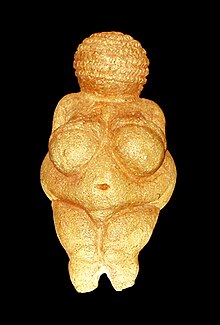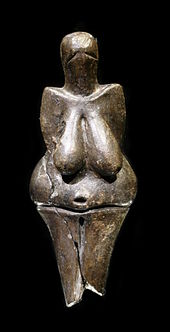Venus figurines
From Wikipedia, the free encyclopedia
A Venus figurine is any Upper Paleolithic statuette portraying a woman,[1] although the fewer images depicting men or figures of uncertain gender,[2] and those in relief or engraved on rock or stones are often discussed together.[3] Most have been unearthed in Europe, but others have been found as far away as Siberia, extending their distribution across much of Eurasia, although with many gaps, such as the Mediterranean outside Italy.[4]
Most of them date from the Gravettian period (26,000–21,000 years ago),[3] but examples exist as early as theVenus of Hohle Fels, which dates back at least 35,000 years to the Aurignacian, and as late as the Venus of Monruz, from about 11,000 years ago in the Magdalenian. These figurines were carved from soft stone (such assteatite, calcite or limestone), bone or ivory, or formed of clay and fired. The latter are among the oldest ceramicsknown. In total, some 144 such figurines are known;[5] virtually all of modest size, between 3 cm and 40 cm or more in height.[1] They are some of the earliest works of prehistoric art.
Most of them have small heads, wide hips, and legs that taper to a point. Various figurines exaggerate the abdomen, hips, breasts, thighs, or vulva, although many do not, and the concentration in popular accounts on those that do reflects modern preoccupations rather than the range of actual artefacts. In contrast, arms and feet are often absent, and the head is usually small and faceless. Depictions of hairstyles can be detailed, and especially in Siberian examples, clothing or tattoos may be indicated.[6]
The original cultural meaning and purpose of these artifacts is not known. It has frequently been suggested that they may have served a ritual or symbolic function. There are widely varying and speculative interpretations of their use or meaning: they have been seen as religious figures,[7] as erotic art or sex aids,[8] or alternatively as self-depictions by female artists.[9]
Contents
[hide]Terminology[edit]
The expression 'Venus' was first used in the mid-nineteenth century by the Marquis de Vibraye, who discovered an important ivory figurine and named it La Vénus impudique or Venus Impudica ("immodest Venus"), contrasting it to theVenus Pudica, Hellenistic sculpture by Praxiteles showing Aphrodite covering her naked pubis with her right hand.[10]
The use of the name is metaphorical, there is no link between the figurines and the Roman goddess Venus, although they have been seen as representations of a primordial female goddess. The term has been criticised for being more a reflection of modern western ideas than reflecting the beliefs of the sculptures' original owners, but the name has persisted.[11]
History of discovery[edit]
Vénus impudique, the figurine that gave the whole class its name, was the very first Paleolithic sculptural representation of a woman discovered in modern times. It was found in about 1864 by Paul Hurault, 8th Marquis de Vibraye at the famous archaeological site of Laugerie-Basse in the Vézère valley (one of the many important Stone Age sites in and around the commune of Les Eyzies-de-Tayac-Sireuil in Dordogne, southwestern France). The Magdalenian "Venus" from Laugerie-Basse is headless, footless, armless but with a strongly incised vaginal opening.[12]
Four years later, Salomon Reinach published an article about a group of steatite figurines from the caves of Balzi Rossi. The famous Venus of Willendorfwas excavated in 1908 in a loess deposit in the Danube valley, Austria. Since then, hundreds of similar figurines have been discovered from the Pyreneesto the plains of Siberia. They are collectively described as "Venus" figurines in reference to the Roman goddess of beauty, Venus, since the prehistoriansof the early 20th century assumed they represented an ancient ideal of beauty. Early discourse on "Venus" figurines was preoccupied with identifying the race being represented; and the steatopygous fascination of Saartjie Baartman, the "Hottentot Venus" exhibited as a living ethnographic curiosity to connoisseurs in Paris early in the nineteenth century.[13]
In September 2008, archaeologists from the University of Tübingen discovered a 6 cm figurine woman carved from a mammoth’s tusk, the Venus of Hohle Fels, dated to at least 35,000 years ago, representing the earliest known sculpture of this type, and the earliest known work of figurative art altogether. The ivory carving, found in six fragments in Germany's Hohle Fels cave, represents the typical features of Venus figurines, including the swollen belly, wide-set thighs, and large breasts.[14][15]
Description[edit]
The majority of the Venus figurines appear to be depictions of females, many of which follow certain artistic conventions, on the lines of schematisation and stylisation. Most of them are roughly lozenge-shaped, with two tapering terminals at top (head) and bottom (legs) and the widest point in the middle (hips/belly). In some examples, certain parts of the human anatomy are exaggerated: abdomen, hips, breasts, thighs, vulva. In contrast, other anatomical details are neglected or absent, especially arms and feet. The heads are often of relatively small size and devoid of detail. Some may represent pregnant women, while others show no such signs.[17] It has been suggested that aspects of the typical depiction and perspective, such as the large and often pendulous breasts, emphasis on the upper rather than lower buttocks, and lack of feet and faces, support the theory that these are self-portraits by women without access to mirrors, looking at their own bodies.[18] The absence of feet has led to suggestions that the figures might have been made to stand upright by inserting the legs into the ground like a peg.
The high amount of fat around the buttocks of some of the figurines has led to numerous interpretations. The issue was first raised by Édouard Piette, excavator of the Brassempouy figure and of several other examples from the Pyrenees. Some authors saw this feature as the depiction of an actual physical property, resembling the Khoisan tribe of southernAfrica, while others interpreted it as a symbol of fertility and abundance. Recently, similar figurines with protruding buttocks from the prehistoric Jōmon period Japan were also interpreted as steatopygia of local women, possibly under nutritional stress.[19]
The Venus of Willendorf and the Venus of Laussel bear traces of having been externally covered in red ochre. The significance of this is not clear, but is normally assumed to be religious or ritual in nature—perhaps symbolic of the blood of menstruation or childbirth. Some buried human bodies were similarly covered, and the colour may just represent life.[20]
All generally accepted Paleolithic female figurines are from the Upper Palaeolithic. Although they were originally mostly considered Aurignacian, the majority are now associated with the Gravettian and Solutrean.[4] In these periods, the more rotund figurines are predominant. During the Magdalenian, the forms become finer with more detail; conventional stylization also develops.
Notable specimens[edit]
| Name | Age (kya, approx.) | Location | Material |
| Venus of Hohle Fels | 35–40 | Swabian Alb, Germany | mammoth ivory |
| Venus of Galgenberg | 30 | Lower Austria | serpentine rock |
| Venus of Dolní Věstonice | 27–31 | Moravia, Czech Republic | ceramic |
| Venus of Lespugue | 24–26 | French Pyrenees | ivory |
| Venus of Willendorf | 24–26 | Lower Austria | limestone |
| Venus of Petřkovice | 23 | Silesia, Czech Republic | hematite |
| Venus figurines of Mal'ta | 23 | Irkutsk Oblast, Russia | ivory |
| Venuses of Buret' | 23 | Irkutsk Oblast, Russia | ivory, serpentine rock |
| Venus of Moravany | 23 | Moravany nad Váhom, Slovakia | mammoth ivory |
| Venus of Savignano | 20–25 | Savignano sul Panaro, Italy | serpentine rock |
| Grimaldi Venuses | 18–25 | Ventimiglia, Italy | ivory, soapstone, serpentine, chlorite |
| Venus figurines of Gönnersdorf | 11,5–15 | Germany | ivory, antler, bone |
| Venus of Monruz | 11 | Switzerland | black jet |
| Venus of Parabita | 12–14 | Parabita, Italy | Horse bone |
Classification[edit]
A number of attempts to subdivide or classify the figurines have been made.[21] One of the less controversial is that by Henri Delporte, simply based on geographic provenance.[22] He distinguishes:
- the Venus figurines of the Pyrenees-Aquitaine group (Venus of Lespugue, of Laussel and of Brassempouy)
- the Venus figurines of the Italian group (Venus of Savignano and of Balzi Rossi)
- the Venus figurines of the Rhine-Danube group (Venus of Willendorf and of Dolní Věstonice)
- the Venus figurines of the Russian group (Kostienki and Zaraysk[23][24] in Russia and Gagarino in Ukraine)
- the Venus figurines of the Siberian group (Mal'ta Venus, Bouret' Venus).
According to André Leroi-Gourhan, there are cultural connections between all these groups. He states that certain anatomical details suggest a shared Oriental origin, followed by a westward diffusion.[25]
Interpretation[edit]
There are many interpretations of the figurines, often based on little argument or fact.[3]
Like many prehistoric artifacts, the cultural meaning of these figures may never be known. Archaeologists speculate, however, that they may be emblems of security and success, fertility icons, or direct representations of a mother goddess. The female figures, as part of Upper Palaeolithic portable art, appear to have no practical use in the context of subsistence. They are mostly discovered in settlement contexts, both in open-air sites and caves;[3] burial contexts are much rarer.[citation needed]
At Gagarino in Russia, seven Venus figurines were found in a hut of 5 m diameter; they have been interpreted as apotropaic amulets, connected with the occupants of the dwelling. At Mal'ta, near Lake Baikal in Siberia, figurines are only known from the left sides of huts. The figurines were probably not hidden or secret amulets, but rather were displayed to be seen by all (a factor that may explain their wide geographic spread). An image of excess weight may have symbolized a yearning for plenty and security.[citation needed]
Helen Benigni argues in The Emergence of the Goddess that the consistency in design of these featureless, large-breasted, often pregnant figures throughout a wide region and over a long period of time suggests they represent an archetype of a female Supreme Creator. Neolithic, Bronze Age, and Iron Age people likely connected the female as a creator innately tied to the cycles of nature: women gave birth and their menstrual cycles aligned with lunar cycles and tides.[26]



No comments:
Post a Comment